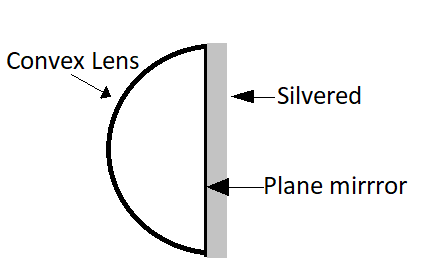
A plano-convex lens (f=20cm) is silvered at the plane surface. The new focal length will be:
A) 20cm
B) 40cm
C) 30cm
D) 10cm
Answer
146.7k+ views
Hint: A Plano-convex lens is a lens which is made by joining a flat plane and a convex lens.
Silvering of flat plane converts it into a mirror as now the light rays will be reflected by the lens instead of passing through after refraction.
The power of a lens is the ability of a lens to converge or diverge a ray of light falling on it.
Complete step by step solution:
The following images show how a Plano-convex lens looks like

Now when its plane part is silvered so it acts as a mirror now, refer the image

Here we can say that it is now a combination of a convex lens and a plane mirror both of which have their powers
The power of a Plano-convex lens is equal to the sum of twice the power of lens and mirror
i.e.,
We know that power of a lens is given by
Where
And the power of a plane mirror is given by
Where
So total power of the setup will be
Here the focal length of the lens is given as
And we know that the focal length of a plane mirror is
Substituting these values in the above equation
Here we get to know that the power of a plane mirror is zero because a plane mirror neither converges or diverges any ray of light falling on it just reflects them back.
Now as we know that the power is the reciprocal of the focal length so the new focal length corresponding to this power will be,
Let new focal length be
We know that
The new focal length of the Plano-convex mirror will be
Note: 1) The power of a lens depends upon its focal length
2) The focal length of a plane mirror is infinity and thus its power is zero
3) Silvering of any lens makes it a mirror because now it will reflect the light rays falling on it
Silvering of flat plane converts it into a mirror as now the light rays will be reflected by the lens instead of passing through after refraction.
The power of a lens is the ability of a lens to converge or diverge a ray of light falling on it.
Complete step by step solution:
The following images show how a Plano-convex lens looks like

Now when its plane part is silvered so it acts as a mirror now, refer the image

Here we can say that it is now a combination of a convex lens and a plane mirror both of which have their powers
The power of a Plano-convex lens is equal to the sum of twice the power of lens and mirror
i.e.,
We know that power of a lens is given by
Where
And the power of a plane mirror is given by
Where
So total power of the setup will be
Here the focal length of the lens is given as
And we know that the focal length of a plane mirror is
Substituting these values in the above equation
Here we get to know that the power of a plane mirror is zero because a plane mirror neither converges or diverges any ray of light falling on it just reflects them back.
Now as we know that the power is the reciprocal of the focal length so the new focal length corresponding to this power will be,
Let new focal length be
We know that
The new focal length of the Plano-convex mirror will be
Note: 1) The power of a lens depends upon its focal length
2) The focal length of a plane mirror is infinity and thus its power is zero
3) Silvering of any lens makes it a mirror because now it will reflect the light rays falling on it
Recently Updated Pages
How to find Oxidation Number - Important Concepts for JEE

How Electromagnetic Waves are Formed - Important Concepts for JEE

Electrical Resistance - Important Concepts and Tips for JEE

Average Atomic Mass - Important Concepts and Tips for JEE

Chemical Equation - Important Concepts and Tips for JEE

Concept of CP and CV of Gas - Important Concepts and Tips for JEE

Trending doubts
JEE Main 2025 Session 2: Application Form (Out), Exam Dates (Released), Eligibility, & More

JEE Main Exam Marking Scheme: Detailed Breakdown of Marks and Negative Marking

JEE Main 2025: Derivation of Equation of Trajectory in Physics

Electric Field Due to Uniformly Charged Ring for JEE Main 2025 - Formula and Derivation

JEE Main Participating Colleges 2024 - A Complete List of Top Colleges

Degree of Dissociation and Its Formula With Solved Example for JEE

Other Pages
JEE Advanced Marks vs Ranks 2025: Understanding Category-wise Qualifying Marks and Previous Year Cut-offs

JEE Advanced 2025: Dates, Registration, Syllabus, Eligibility Criteria and More

JEE Advanced Weightage 2025 Chapter-Wise for Physics, Maths and Chemistry

Electric field due to uniformly charged sphere class 12 physics JEE_Main

Learn About Angle Of Deviation In Prism: JEE Main Physics 2025

Ideal and Non-Ideal Solutions Raoult's Law - JEE




